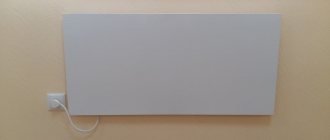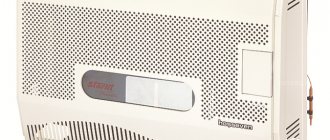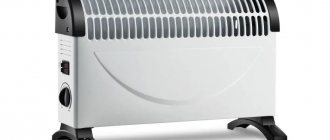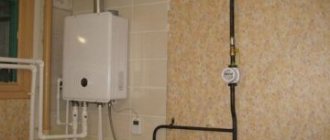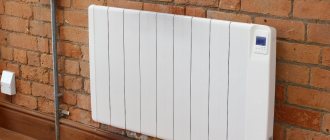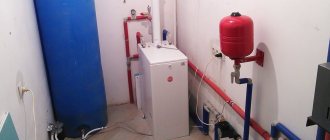During the winter period in Russia, housing needs to be heated even in the southern regions, which determines the demand among our consumers for many types of stationary and portable heating equipment. A large niche in the Russian market of heaters offered by foreign and domestic manufacturers is occupied by a group of infrared devices with a general principle of influencing the environment, but consisting of subgroups that differ in design and, as a result, functionality and efficiency.
Let's take a closer look at one of the types of infrared devices for heating homes - a wall-mounted film heater, which has been used in everyday life relatively recently, but, due to a number of advantages, is already in stable consumer demand.
Operating principle of IR heaters
Infrared rays are non-visible electromagnetic waves with a length from 0.74 microns to 1.5-2 mm. Any heated body becomes a source of infrared radiation - an emitter, and the emitter is heated by converting the energy of one of the types of energy carrier - electric current, gas, solid or liquid fuel - into heat.
Infrared radiation, encountering an obstacle in the path of propagation, causes vibration of its surface layer with an increase in the speed of movement of molecules, which causes an increase in the temperature of the object to a certain depth.
The wavelength range of infrared radiation, in turn, is divided into the following components:
- short-wave – 0.74-2.5 microns;
- average wavelength – 2.5-50.0 microns;
- long-wave – 50.0-2000.0 microns.
The intensity of heating of the surface of objects depends on the temperature of the emitter - the higher it is, the shorter the wavelength of infrared radiation and the greater the depth of heating of the surface of the obstacle. When IR rays propagate, they do not change the temperature characteristics of the transit medium - the air is heated not by their passage, but by the transfer of heat to it by heated objects.
The method of heat transfer through infrared radiation is not associated with conduction or convection, so IR heaters are capable of transferring heat even through a vacuum.
How does infrared heating work?
Infrared radiation heats all surfaces in the room. This type of heating can be compared to the warming effect of simple sunlight. Rays of thermal energy pass through the air and affect all surfaces of objects in the room. By receiving radiated heat using infrared film heating, the walls, floors and pieces of furniture warm up well, then the temperature from them enters the surrounding space.
The floor receives the most heat, and the air near the ceiling is cooler. As users of infrared film heating note, the room becomes warm in just a couple of minutes. Heating a house using infrared radiation allows you to obtain a uniform temperature distribution.
Film electric heater device (PLEN)
*
All IR heaters are divided into high-temperature short-wave and low-temperature long-wave. Film-type heaters belong to the second group.
Visually, a film IR electric heater is a flexible sheet or strip of a certain format. If the model is not decorative (a picture heater), then the transparent outer layers allow you to see the location of the component elements.
Important! PLEN is an abbreviation meaning “film radiant electric heater”, and not a registered trademark.
Structurally, any type of film-type household heater includes the following components:
- resistive type heating elements - made of carbon-containing materials or metals, tape or plate, capable of heating up to 35-55 degrees when an electric current passes through them;
- heat distributing base - one or two layers of thin aluminum foil on which resistors are mounted to evenly distribute the heat from their heating over the surface of the screen;
- thermostat with temperature sensors;
- two protective layers of laminated film with a melting point of up to 210 degrees, between which there is foil with heating elements;
- cable for connecting PLEN to the network.
The total thickness of the heating sheet does not exceed 1.5 mm.
Schematically, PLEN can be depicted as follows (the thermostat is installed separately):
1 – contacts for connecting the device to a 220 V network;
2 – flexible two-layer shell made of polymer film on a supporting lavsan or polyester base;
3 – points of industrial, carefully insulated connection of the supply wire with the contacts of the heaters (independent cable replacement is not provided);
4 – heating resistive elements (tape or separate plates connected by conductors);
5 – aluminum foil;
6 – hologram to protect the heater from counterfeit production.
Operating principle of PLEN
*
When the power cable is connected to the network, the resistive elements heat up to a preset temperature value (35-50 degrees) within 10 seconds. Film heaters for non-domestic purposes (for mini-saunas, dryers of agricultural products), used in rooms with ceiling heights of more than 3.5 m, have resistive elements of wire, tape, plate design made of nichrome, fechral or multicomponent alloys, providing a higher temperature heating
The heat of the heaters is transferred to the foil and, due to the high thermal conductivity of aluminum, is evenly distributed over its surface, which allows the heater to generate IR radiation of equal intensity over its entire area. When the air in the room reaches the set temperature value, the film heater turns off based on a signal from the temperature sensor in the thermostat, and objects heated by radiation continue to give off heat. When the temperature in the room drops by 1 degree, the thermostat will turn on again, and the film heater will perform a new radiation cycle.
A correctly calculated combination of the material of the reflective layer, its thickness, and the arrangement of resistive heaters ensures the conversion of electricity into heat, and then into infrared radiation with a wavelength of 8-15 microns favorable for human perception.
Important! When the current increases or the thermostat fails, the temperature of the resistive graphite heaters will increase, which will lead to their destruction and failure of the household film heater as a whole, that is, the resistive elements also perform the protective function of fuses.
Composition and properties of high resistance wires
The following requirements apply to wires in strip heaters:
- High heat resistance and resistance to oxidation at high temperatures;
- Ability to withstand mechanical loads at high temperatures;
- Stability of electrical parameters (resistance) at high temperatures;
- Maintain wire Ø dimensions to prevent changes in power consumption.
Might be interesting
Thermal insulation
Insulating the ceiling in a bathhouse - methods, materials, useful...
Thermal insulation
Tables of comparative characteristics of thermal insulation…
Thermal insulation
Why polyurethane foam insulation is the best...
Thermal insulation
Self-adhesive thermal insulation: how to choose and apply?
To meet these requirements, heating wire made of nichrome alloys is best suited; double or triple nichrome is often used. The double nichrome alloy contains 20% nichrome, the remaining 80% is nickel; these are high-quality but expensive wires. The ternary alloy contains 12-14% nichrome, 60% nickel, and the rest is iron impurities.
Wires with increased heat resistance are made from iron-chromium-aluminum alloy: 12-13% chromium, 82-84% iron and 3-5% aluminum; if nickel is absent, the alloy is called fechral. Chromium oxide is applied to the outer layer of the wire, as it has high heat resistance and protects the inner part of the wire from oxidation and destruction.
Depending on these characteristics, the functional purpose and operating conditions of the tape are determined.
Types of film heater
One of the main differences between film-type electric heaters is their format and size. PLENs are produced in the form of tapes of various lengths and widths. Independent correction of the dimensions of such films is impossible, therefore PLENs are produced in a wide range of dimensions, allowing you to choose the best option. The most common sizes of tapes in width are 35, 51 and 65 cm.
Films with a width of 35 and 51 cm have two zones that are free from the location of resistive elements and are intended for installation using a stapler - along the edges. Ribbons 65 cm wide have three such zones - two at the edges and one along the middle (as an option - two at the edges and between them transverse with a certain pitch).
Flexible film IR heaters can be installed on both vertical and horizontal surfaces - the design of film-type electric heaters does not depend on the location of its installation, with the exception of PLEN-pictures, which by definition should be located in places of the best view - on the walls. The classification of a particular film heater as a wall, floor or ceiling device is determined only by its design location - an important factor affecting the efficiency of this IR device. Thus, a film heater on the wall, after being installed on the ceiling, in everyday life turns into a ceiling heater.
Let's consider options for placing PLENs in premises in order of increasing efficiency of their use.
Wall arrangement of film heaters
*
Placing PLENs on the wall is the least effective due to the limited sector of influence of infrared radiation on the enclosing structures - most of the infrared rays heat the surface of the wall opposite, with almost no effect on the floor and ceiling.
Film devices permanently mounted on the wall are effective as the main means of heating only if the opposite base has a significant area - then the heat transfer from its heated surface into the air will be quite noticeable.
If the area of film heaters installed on the wall is not significant, and the base, on the contrary, also has window openings, then the efficiency of such an IR heater will be low. But small-area stationary wall-mounted film heaters are convenient as an additional means of heating - to increase the comfort of the temperature regime of a certain place or zone in the room.
A type of film-type wall heaters are portable IR devices with artistic decoration that imitate paintings. In order for their use to be rational and effective, picture heaters must be used in small rooms for heating, for example, a workplace, or in groups, the total heat transfer area of which will be commensurate with the size of the room.
Floor placement of film-type IR heaters
Infrared radiation from devices located in this way affects the floor covering and ceiling. A warm floor surface increases the comfort of human contact with it - you can walk without shoes, sit or lie on the floor, etc. In addition, the transfer of heat from the floor to the cold lower layers of air in the room also warms the room, as it causes the occurrence of convective flows. But the energy of that part of the IR rays that penetrates the floor covering is spent on heating the ceiling, which is less efficient - the ceiling base has little need for this, since its temperature is already quite high as a result of convection.
Important! It is not advisable to place film IR heaters in furniture locations - bulky objects made of materials with low thermal conductivity create barriers to infrared radiation.
Ceiling installation of infrared film heaters
When using film-type heating devices as the main means of heating, placing them on the ceiling is the most effective, since this arrangement ensures that all enclosing structures of the room, regardless of configuration, and the objects in it are exposed to radiation.
Important! When choosing a ceiling for installation of PLENs, it is necessary to take into account that the efficiency of heating with IR rays decreases with increasing distance to the emitter. Film-type infrared heaters are low-temperature, long-wave devices, so their use at ceiling heights of more than 3.5 m is irrational.
The advantage of ceiling placement of PLENs, in addition to high heating efficiency, is the minimal risk of accidental damage to the heater, which is located at a fairly safe distance from the traffic zone. However, there are also disadvantages - the location on the ceiling makes the PLEN vulnerable to leakage from above, and installation work at height is more labor-intensive.
Characteristics of an electric heater of film construction.
When choosing a film IR heater, you must be guided not only by its size - PLENs also have other characteristics, including those that are important for specific conditions:
- voltage of current consumption is mainly 220 V, but they are also produced at 110 V;
- power - up to 500 W, energy consumption per square meter of film heater (power density) can range from 70 to 170 W;
- maximum heating temperature – 35-50 degrees;
- current consumption – 0.7-1.2 A;
- specific gravity – up to 350 g/m2.
To make the description clearer, we summarize the data on the characteristics of film heaters in relation to their standard sizes:
*
Installation of film-type IR heaters
Installation of flexible film heaters, regardless of the installation location, does not require the contractor to have high-level professional skills, but must be carried out in compliance with the following rules:
- the installation site of the PLEN must be level and dry;
- cutting rolls, if provided for by the model, should be performed only according to the markings specified by the manufacturer;
- testing the functionality by plugging in a rolled-up heater is prohibited;
- the length of one strip film fragment should not exceed 8 m;
- adjacent strips of the heating system are located at a distance of at least 5 mm;
- bending the PLEN at an angle of more than 90 degrees is not allowed;
- installation of the film to the base is carried out with staples using a construction stapler or special fasteners (the use of ordinary nails and self-tapping screws is not effective);
- It is prohibited to carry out installation work at sub-zero air temperatures - after warming up the room, the film strips will increase in size and form folds.
Sequence of installation of film IR heaters
To protect against overheating, the base for placing the PLEN must be equipped with a foil reflective screen that acts as a heat and water insulator, for example, penofol, isolon.
The protective coating is mounted on the base with an overlap of adjacent edges of 3-5 cm; to speed up the process, it is advisable to use special fasteners for fastening, which are available in a wide range on sale.
From above, the joints of the screen strips are glued longitudinally with special foil tape.
The elements of the film heater are mounted on top of the laid screen - after preliminary layout and in accordance with the installation instructions supplied with the device. Installation is carried out taking into account the rule - for 1 square meter of flexible film there should be 8-10 fastening elements.
When the heating circuit is ready to be installed, it is connected to the thermostat, which should be located at a height of 1-1.5 m from the floor, and the system’s functionality is checked.
In addition, to correctly monitor the temperature in the room, the thermostat must be located away from other heating devices, have a thermal insulation pad underneath, and be protected from direct sunlight and drafts.
If the results of testing the IR device are positive, finishing materials are laid - floor covering or suspended ceiling, which are installed with a gap of 10-15 mm between the cladding and the film.
Important! There are no materials that are absolutely transparent for PLENs - any finishing finish on top of the film is a screen that attenuates radiation to one degree or another.
Read on the topic - how to attach, lay and glue penofol.
Self-regulating heating temperature tape
The peculiarity of this tape is the use of a semiconductor film matrix between two copper conductors. The resistance of a semiconductor changes depending on the ambient temperature. As the temperature decreases, the resistance of the matrix decreases, the current and heating temperature increase. As the temperature rises, the reverse process occurs.
Technical characteristics of the self-regulating heating tape HTM 10-15 W/m:
- operating temperature – 65 °C;
- maximum permissible temperature – 85 ̊С, but not more than 1000 hours;
- power supply from a 220V network, there are models designed for 110V.
The film semiconductor matrix with copper conductors is coated with a layer of modified polyophelin for sealing against moisture. For mechanical protection, a braid of tinned copper wire is put on the tape, which is grounded during installation. This measure prevents electric shock due to a short circuit; the outer shell is made of ordinary PVC materials.
Structure of self-regulating heating tape
It is recommended to use this tape for heating individual sections of water supply pipelines, roofing coverings, sidewalks and steps at the entrance to buildings. Tapes are successfully used in “warm floor” technologies.
The advantages of a self-regulating tape are obvious:
- Automatic temperature adjustment;
- Economical mode of electrical energy consumption;
- Only those parts of the circuit where the temperature is low are heated;
- The ability to cut the tape into sections of the required length;
- Light weight, flexible, easy to operate and easy to install.
The properties of the film matrix make it possible to heat individual areas where the temperature is lower than the set temperature. This operating mode significantly saves energy consumption.
One example of the practical application of HTM 10-15 W/m is for heating pipelines.
An example of attaching heating tape to pipes
The tape is securely fixed along the pipes with plastic clamps, after which thermal insulation and an outer protective sheath (plastic corrugated tube) must be put on the pipes. The ends of the wires are connected to the network in a distribution box, from where the line goes to the circuit breaker in the distribution board (distribution panel).
The tape cannot be attached to moving structural elements; for safe operation, the tinned shielding shell must be connected to the ground loop. In the tape circuit, it is connected to an RCD located on the DIN rail in the control panel; the protective shutdown leakage current is 30 mA.
The matrix begins to pass currents to heat the tape at a temperature of +5 ̊C, the maximum temperature is 85 ̊C. If there is no need for high temperatures, in order to save energy, it is possible to install a thermostat in the circuit, limiting the maximum temperature to 50 °C.
Some notes and recommendations for use
- One should not expect high efficiency from film IR heaters, as well as from any other heating units, in the absence of thermal insulation of the housing enclosing structures.
- Marketers' statements about the PLEN wavelength of 8 microns, supposedly optimal for human perception, do not correspond to reality - the radiation of IR heaters is always in a certain range and cannot consist of waves of any one length.
- Installing PLEN in one room, even over the entire area of the enclosing structures, will not solve the problem of heating other rooms for the house.
- The operation of PLEN is not accompanied by a decrease in oxygen in the room air, so there is no need to increase the frequency of room ventilation when using film heaters.
- It is not necessary to turn off the PLEN system in the summer - just set the thermostat to the desired temperature value.
- The durability of infrared film heaters declared by manufacturers (up to 50 years) is a hypothetical value, since PLENs began to be produced relatively recently.
- The safety requirements for household electrical appliances, including film-type ones, are set out in GOST R 52161.2.96-2006.
Manufacturer's choice
The characteristics of PLEN are approximately the same, since the same production technology is used, so statements about the advantages of a particular brand are not always reliable. PLEN has proven itself well, in particular EVO 300; you can buy this film in almost any large city, even Khabarovsk or Irkutsk. There are also many good reviews about Fracarro and Orient heating plates.
However, it should be taken into account that energy-saving technologies do not stand still, so new products regularly appear on the market that make it possible to reduce heat loss, and, accordingly, electricity consumption. Therefore, when designing alternative heating systems, this issue should be carefully studied.
